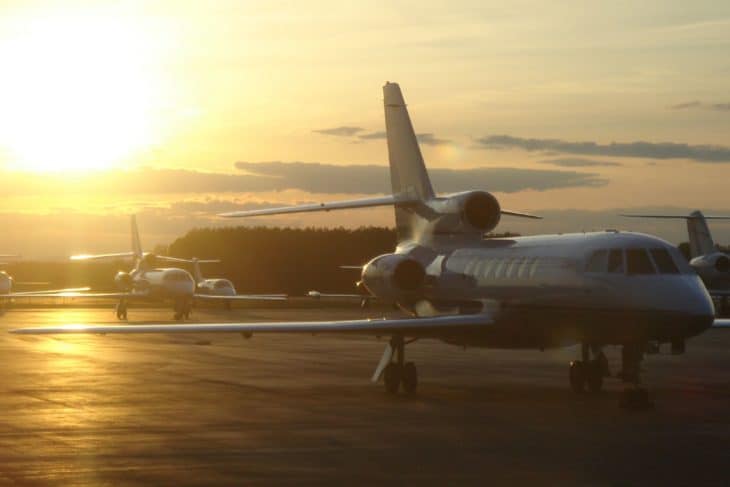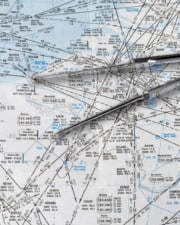Even the most ordinary things in aviation sound fancy, mostly because they get fancy-sounding acronyms. What sounds classier than a gas station and a corner mini-mart? In aviation, that would be an FBO.
Table of Contents
FBO stands for fixed-based operator and is a business found at an airport. The most common services offered by FBOs are fuel, aircraft parking, hangers, flight instruction, maintenance, or aircraft rentals.
What is an FBO?
A fixed-base operator is a business that doesn’t move. That’s opposite to most things in aviation, which are travel related. As such, FBOs are physical businesses located at airports around the world.
Most commonly, FBOs are the places where aircraft can park and get fuel. Depending on the type of airport, these can range from merely a parking spot in the grass and a self-serve pump to elaborate red-carpet affairs with concierge services and catering.

FBOs are built to serve the most common type of customers at the airport. If the airport is made up of general aviation pilots flying Cessnas around, the FBO will likely be an informal affair where you can rent planes and get fuel.
If, on the other hand, the airport is frequented by corporate charter aircraft and their passengers, the FBO will provide services those customers need. This might include hangar space, rental cars, catering, and equipment for larger aircraft like lav service and tugs.
FBOs are inherently a commodity of general aviation. Airlines have their own services and facilities at passenger terminals. Military aircraft occasionally use FBOs, but more often stick with their facilities at airbases. The result is that private pilots and charter flights use FBOs.
Nearly every airport has an FBO of some sort. Even large international airports have an FBO for charter aircraft to use. In short, if the airport has any regular amount of transient aircraft traffic, then there is probably an FBO to serve their needs.
Common FBO Amenities
So what do transient aircraft always need? While fuel, tie-downs, and hangar space are all good answers, there is something that all pilots and passengers know the FBO should have. Clean bathrooms.
Don’t laugh too hard. The bathroom is the first place that most pilots and passengers will go. Most will breeze by the front desk and the carefully trained customer service agents. First impressions are essential, and a well-run FBO has outstandingly clean and well-appointed bathrooms.
But all of the other amenities are important too. Like any business, customer service varies from place to place.
Most FBOs include some sort of pilot lounge area. The nicer the pilot lounge and amenities for the crew, the more likely they will come back. Some spots have unlimited gourmet coffees, cookies, and even things to pass the time, like pool tables. Corporate pilots spend a lot of time in FBOs waiting for their clients to arrive. Quiet crew rest areas are always welcome for these pilots, as are computer terminals and landlines for flight planning.
Another standard amenity for some FBOs is a crew car. This car is for short local trips and is excellent for general aviation pilots since they seldom have a car when they are from out of town. This is an example of FBOs meeting a need that might not be obvious at first but is of enormous value to their customers.
FBO Ownership
The ownership of an FBO is often a private company. While the airports themselves are public entities owned by city, county, or state governments, those governments typically lease out the business space at the field to private companies.

There are exceptions to the rule, however. More than a few airports, especially very small fields with little air traffic, have government-owned and managed FBOs. These are typically one-off operations where no private business has set up shop yet, but where there is a demand for services.
Several multi-national corporations run FBOs all over the world. The largest FBO chain is Signature Flight Support, which has almost 200 FBOs covering every continent (except Antarctica). Another major player is Atlantic Aviation, which has over 60 US locations.
FBOs often differentiate themselves based on unique market needs. FBOs at small rural fields attract private weekend flyers with pancake breakfasts or afternoon barbecues. Secondary airports near large city centers will offer rates on tie-downs and fuel well below what they cost at the primary airports.
FBO Management
Much like an airline terminal, a good FBO is designed to facilitate the movement of people from the airside airport environment to the city’s landside. Lineworkers signal pilots into their parking spots. Often, planes are parked near the FBO for convenience and then moved to remote parking areas by tugs after the passengers have disembarked.
Once inside the FBO itself, crew and passengers pass by a front desk area. The desk representatives are the leading customer service agents. While they handle payment and scheduling of services, they also often act as concierges, working out local transportation and aircraft services needs.
FBOs are usually designed with a fast walk-through design, so that crew can leave the aircraft, walk through a simple waiting area, and straight out to the street for rental cars, taxi service, or other land transportation.

Interior office space at FBOs is often leased to other businesses. Flight training providers, aircraft rentals, and maintenance shops are just a few examples of the companies that might be run out of a major FBO. In some instances, these companies are owned by the same company, while often they are independent of one another.
Related Posts












